Monthly Summaries
Issue 33, September 2019
[DOI]
!['Unprecedented and dangerous changes [are] being driven by global heating’](images/33/callout1.jpg)
A farmer in a drought-stricken field of crops in Suffolk, UK. Source: Clynt Garnham Agriculture/Alamy Stock.
September media attention to climate change and global warming was at its highest level globally in nearly a decade. Coverage was most abundant in history apart from attention in November and December 2009 associated with the Copenhagen round of climate talks (COP15) and the University of East Anglia email hacking scandal ‘climate-gate’. Compared to the amount of coverage in the previous month of August, global coverage was up nearly 24% and compared to the amount of coverage a year ago (September 2018), it was up 126%. Compared to August 2019 overage also was up across all regions: Africa (+10%), Asia (+32%), Europe (+25%), Middle East (+6%), North America (+13%), Oceania (+20%), and Latin America (+28%). Compared to the previous month, coverage also was up across the wire services (+25%) and across global radio segments (+59%).

Figure 1. Newspaper media coverage of climate change or global warming in thirteen sources in Latin America from January 2005 through September 2019.
This burgeoning coverage lends itself to the notion that media are treating climate change not as a distant challenge in space and time, but as an intersectional set of issues in the here and now. Figure 2 shows trends in newspaper media coverage at the global scale – organized into seven geographical regions around the world – from January 2004 through September 2019.

Figure 2. Newspaper media coverage of climate change or global warming in ninety-six sources in seven different regions around the world, from January 2004 through September 2019.
Figure 3. Newspaper media coverage of climate change or global warming in five sources in USA from January 2000 through September 2019. |
Trends, however, varied across countries. MeCCO documented particularly strong signals in the quantity of coverage in the United States (US) in September in both television and print media. US television media reached its second highest levels (after the aforementioned period of November and December 2009. US print media of climate change or global warming reached an all-time high since MeCCO monitoring began in January 2000. US print media coverage of climate change surpassed the previous high water mark achieved in January 2017 (largely dominated by speculation of how newly inaugurated US President Donald Trump would impact global efforts to combat climate change (See MeCCO Summary 1 for details). Contributing to these increases, a ‘Covering Climate Now’ campaign was led by US-based media organizations Nation and Columbia Journalism Review designed to increase media coverage of climate change across more than 300 participating outlets. With a combined potential audience of over 1 billion readers, viewers and listeners, this initiative contributed to the increases in coverage that we in MeCCO detected.
Similarly, New Zealand print media coverage reached an all-time high, while the amount of coverage in Germany and Spain were second highest, and the United Kingdom reached the fourth highest on record in the month of September. Also in September 2019, Indian print media coverage reached an all-time high (see Figure 5 for more details). Compared to the previous month of August 2019, coverage was up in all eleven countries MeCCO monitors, except one: Canada (+31%), India (+26%), Germany (+26%), Spain (+81%), Japan (+49%), New Zealand (+17%), Norway (-13%), Sweden (+3%), UK (+8%), and US (+6%).
Below we describe media coverage that focused on political, economic, cultural, ecological, meteorological and scientific dimensions.
 In September, media political and economic connections with climate issues dominated coverage around the world. For example, the month began as many United States (US) Democratic presidential hopefuls pushed out climate plans ahead of a September 4 climate town hall hosted by CNN. Journalists Juana Summers and Ellen Knickmeyer reported, “Five Democratic presidential candidates in the span of 24 hours have released sweeping plans to address climate change, ahead of a series of town halls devoted to the issue. On Wednesday, California Sen. Kamala Harris and South Bend, Indiana, Mayor Pete Buttigieg each unveiled their climate plans. New Jersey Sen. Cory Booker, Massachusetts Sen. Elizabeth Warren and former Obama cabinet member Julián Castro each laid out theirs on Tuesday. The flurry of plans comes ahead of a CNN town hall event on global warming, which 10 Democrats seeking the White House plan to attend. The forums come after liberals had demanded that the Democratic Party focus at least one debate on climate change, but a climate debate resolution was defeated at the Democratic National Committee’s summer meeting last month. Many Democrats see climate change as an urgent crisis. The issue is so urgent among Democratic voters that Washington Gov. Jay Inslee made action to limit the worst extremes of climate change the core of his presidential bid. But Inslee dropped out of the presidential race in August after failing to earn a spot in the September primary debate. Inslee would not have been invited to Wednesday’s climate change forum, either, having fallen short of the polling criteria. Since he abandoned his presidential bid, a number of candidates including Harris and Warren have embraced parts of the agenda he championed”.
In September, media political and economic connections with climate issues dominated coverage around the world. For example, the month began as many United States (US) Democratic presidential hopefuls pushed out climate plans ahead of a September 4 climate town hall hosted by CNN. Journalists Juana Summers and Ellen Knickmeyer reported, “Five Democratic presidential candidates in the span of 24 hours have released sweeping plans to address climate change, ahead of a series of town halls devoted to the issue. On Wednesday, California Sen. Kamala Harris and South Bend, Indiana, Mayor Pete Buttigieg each unveiled their climate plans. New Jersey Sen. Cory Booker, Massachusetts Sen. Elizabeth Warren and former Obama cabinet member Julián Castro each laid out theirs on Tuesday. The flurry of plans comes ahead of a CNN town hall event on global warming, which 10 Democrats seeking the White House plan to attend. The forums come after liberals had demanded that the Democratic Party focus at least one debate on climate change, but a climate debate resolution was defeated at the Democratic National Committee’s summer meeting last month. Many Democrats see climate change as an urgent crisis. The issue is so urgent among Democratic voters that Washington Gov. Jay Inslee made action to limit the worst extremes of climate change the core of his presidential bid. But Inslee dropped out of the presidential race in August after failing to earn a spot in the September primary debate. Inslee would not have been invited to Wednesday’s climate change forum, either, having fallen short of the polling criteria. Since he abandoned his presidential bid, a number of candidates including Harris and Warren have embraced parts of the agenda he championed”.
Figure 4. World cloud for US newspapers (Washington Post, Wall Street Journal, New York Times, USA Today, and Los Angeles Times) in September 2019. |
Meanwhile Wall Street Journal reporters Chad Day and Tarini Parti wrote, “Four more Democratic presidential candidates have rolled out plans to address climate change through trillions of dollars in government investment and a fundamental overhaul of the American energy economy. Sens. Kamala Harris of California, Cory Booker of New Jersey, Elizabeth Warren of Massachusetts and South Bend, Ind., Mayor Pete Buttigieg—all of whom had previously endorsed the Green New Deal, a sweeping proposal aimed at weaning the U.S. economy off fossil fuels—unveiled detailed plans ...”
In early September there was a 7-hour marathon of CNN town halls, featuring ten 2020 Democratic candidates in 40-minute consecutive segments. In contrast to the up to 15 minutes of climate change discussion in the June debate, this dedicated time to the intersectional climate challenge significantly boosted media attention both within the event itself, as well as through media accounts that followed.
Stories abounded. For example, journalist Aamer Madhani from USA Today reported, “There’s perhaps no topic that more starkly divides Democratic hopefuls and President Trump than the debate on climate change. Democrats writ large see global warming as an existential crisis, while Trump has dismissed the issue as a Chinese-made “hoax". He has incorrectly suggested wind turbines cause cancer…until this week, global warming has remained largely a backburner issue in an internal Democratic debate that’s largely focused on who is best equipped to take on Trump in the general election and whether pursuing Medicare for All is the best way to fix health care in America. That could be changing. Capped with Wednesday's CNN's climate town hall — coming as Hurricane Dorian bears down on the southeastern United States — top Democratic hopefuls this week tried to demonstrate how they would approach turning the tide on global warming should they become the next commander-in-chief”.
Figure 5. Number of news stories per day per outlet in September 2019 across Indian newspapers (The Indian Express, The Hindu, Hindustan Times, and The Times of India). |
As another example (among many), New York-based Guardian journalists Emily Holden and Oliver Milman noted, “Democrats vying for president revealed a fundamental split over how aggressively the US should tackle climate change in a seven-hour town hall meeting on Wednesday. Bernie Sanders painted an apocalyptic future wreaked by the climate crisis and pledged to wage war on the fossil fuel industry. A high-energy Elizabeth Warren urged optimism for building a better America and the former vice-president Joe Biden, who has a pitched a more moderate proposal, said he would push other nations to recommit to stronger action”.
Then in mid-September the United Nations (UN) General Assembly and dedicated day – the Climate Action Summit – addressing climate policy action further boosted media attention. Among many media accounts, BBC journalist Roger Harrabin commented, “The UN’s climate summit has closed amidst cautious praise for its achievements, and bitter condemnation for its failures. On the plus side, more than 60 nations announced they were working on or exploring plans to reduce greenhouse gas to virtually zero. And a similar number said they would definitely boost their climate change ambitions by next year. On the minus side, the campaigner Greta Thunberg blasted leaders for what she called inadequate ambition that risked the future of the young. Germany’s pledge, for instance, was described by critics as totally unfit to meet carbon-cutting targets it’s already promised. And scientists will warn on Tuesday of alarming changes in the natural world, including melting ice and sea level rise beyond previous projections. So it’s possible to describe the UN summit as a cup half-full, or a cup three-quarters empty. That said, there were very clear signs that around the world people are waking up to the threat of an over-heating climate. India, China and the EU say they will deliver tougher carbon-curbing plans in 2020”.
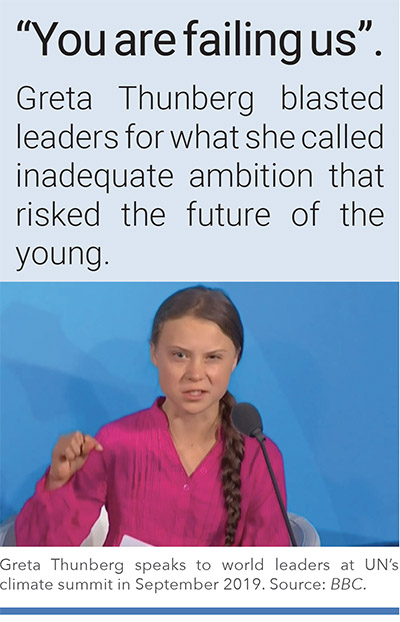 Meanwhile, Associated Press journalist Seth Borenstein noted, the UN Secretary-General Antonio “Guterres opened the summit Monday by saying: “Earth is issuing a chilling cry: Stop.” He told the more than 60 world leaders scheduled to speak that it’s not a time to negotiate but to act to make the world carbon neutral by 2050. “Time is running out,” he said. “But it is not too late.” Scolded for doing little, leader after leader promised the United Nations on Monday to do more to prevent a warming world from reaching even more dangerous levels. As they made their pledges at the Climate Action Summit, though, they and others conceded it was not enough…Secretary-General Antonio Guterres concluded the summit by listing 77 countries that committed to carbon neutrality by 2050, 70 nations pledging to do more to fight climate change, with 100 business leaders promising to join the green economy and one-third of the global banking sector signing up to green goals. “Action by action, the tide is turning,” he said. “But we have a long way to go.” Businesses and charities also got in on the act, at times even going bigger than major nations. Microsoft founder Bill Gates announced Monday that his foundation, along with The World Bank and some European governments, would provide $790 million in financial help to 300 million of the world’s small farmers adapt to climate change. The Gates foundation pledged $310 million of that”.
Meanwhile, Associated Press journalist Seth Borenstein noted, the UN Secretary-General Antonio “Guterres opened the summit Monday by saying: “Earth is issuing a chilling cry: Stop.” He told the more than 60 world leaders scheduled to speak that it’s not a time to negotiate but to act to make the world carbon neutral by 2050. “Time is running out,” he said. “But it is not too late.” Scolded for doing little, leader after leader promised the United Nations on Monday to do more to prevent a warming world from reaching even more dangerous levels. As they made their pledges at the Climate Action Summit, though, they and others conceded it was not enough…Secretary-General Antonio Guterres concluded the summit by listing 77 countries that committed to carbon neutrality by 2050, 70 nations pledging to do more to fight climate change, with 100 business leaders promising to join the green economy and one-third of the global banking sector signing up to green goals. “Action by action, the tide is turning,” he said. “But we have a long way to go.” Businesses and charities also got in on the act, at times even going bigger than major nations. Microsoft founder Bill Gates announced Monday that his foundation, along with The World Bank and some European governments, would provide $790 million in financial help to 300 million of the world’s small farmers adapt to climate change. The Gates foundation pledged $310 million of that”.
In the US context, the mid-September confrontation by the Trump administration with the California state government garnered media attention. For example, Los Angeles Times journalists Alexa Díaz and Anna M. Phillips observed, “The Trump administration warned California officials Thursday that the state is “failing” to meet federal water quality standards, the latest move in the president’s escalating political feud with the state’s liberal leaders. In a letter to California Gov. Gavin Newsom, Environmental Protection Agency Administrator Andrew Wheeler threatened possible enforcement action if the state did not improve the way it deals with lead, arsenic and human waste in its water. Wheeler wrote that officials in San Francisco, Los Angeles and the state as a whole “do not appear to be acting with urgency to mitigate the risks to human health and the environment that may result from the homelessness crisis.” The administrator’s accusations came after several weeks of mounting tension between the president and California officials. This week, the EPA threatened to cut federal transportation funding from California as punishment for not submitting timely plans for controlling air pollution, an announcement that came amid a legal fight between state and federal powers over whether California can set tougher car emissions standards than those required by the federal government”.
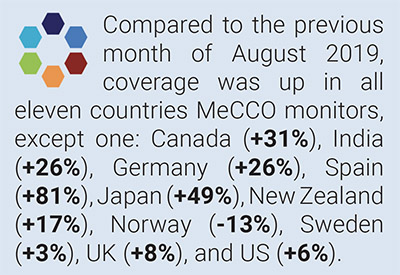 As such, ecological and meteorological content shaped media coverage in September. Of note, the month began with Hurricane Dorian tearing a path of destruction through the Bahamas. On September 6th, NBC News journalist Linda Givetash reported, “The number of people confirmed dead after Hurricane Dorian tore through the Bahamas rose to 30 late on Thursday, but was expected to rise dramatically as the country assessed the devastation. Crews assembled to survey the damage have a daunting task of inspecting each home and collapsed structure scattered around the 50-mile range of islands to locate the dead, the country's health minister, Duane Sands, told NBC News. "It is a horrendous challenge right now and the process of certification and confirmation certainly does not in any way relate to the findings in the field," he said, adding that the findings suggest the death toll "will rise dramatically"”.
As such, ecological and meteorological content shaped media coverage in September. Of note, the month began with Hurricane Dorian tearing a path of destruction through the Bahamas. On September 6th, NBC News journalist Linda Givetash reported, “The number of people confirmed dead after Hurricane Dorian tore through the Bahamas rose to 30 late on Thursday, but was expected to rise dramatically as the country assessed the devastation. Crews assembled to survey the damage have a daunting task of inspecting each home and collapsed structure scattered around the 50-mile range of islands to locate the dead, the country's health minister, Duane Sands, told NBC News. "It is a horrendous challenge right now and the process of certification and confirmation certainly does not in any way relate to the findings in the field," he said, adding that the findings suggest the death toll "will rise dramatically"”.
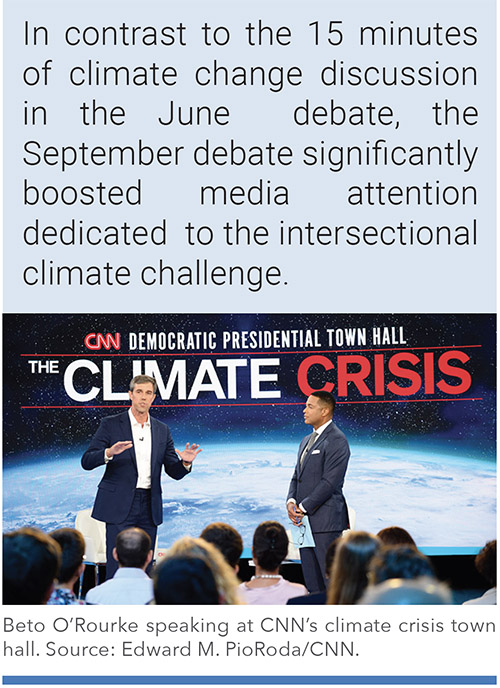 CBS News reported that same day, “CBS News flew with the U.S. Coast Guard over the areas hit hardest on Wednesday, seeing home after home torn apart. The U.N. said 70,000 are in immediate need of aid. Aboard the HC-144 cargo plane, the devastation is clear. The fragile islands were no match for Dorian's Category 5 fury and the landscape looks like a bomb site. Not only was the Coast Guard in rescue mode, but U.S. Customs and Border Protection is also helping out”. Also on September 6th, CNN journalist Madeline Holcombe and Dakin Andone added, “The US Coast Guard said it had rescued 205 people as of Friday. Rescues have concentrated on Bahamas' northern islands as international teams sent small planes and helicopters to reach those stranded and feed the displaced”.
CBS News reported that same day, “CBS News flew with the U.S. Coast Guard over the areas hit hardest on Wednesday, seeing home after home torn apart. The U.N. said 70,000 are in immediate need of aid. Aboard the HC-144 cargo plane, the devastation is clear. The fragile islands were no match for Dorian's Category 5 fury and the landscape looks like a bomb site. Not only was the Coast Guard in rescue mode, but U.S. Customs and Border Protection is also helping out”. Also on September 6th, CNN journalist Madeline Holcombe and Dakin Andone added, “The US Coast Guard said it had rescued 205 people as of Friday. Rescues have concentrated on Bahamas' northern islands as international teams sent small planes and helicopters to reach those stranded and feed the displaced”.
By September 11, many media reports shared the updated counts of those missing, dead and displaced in the Bahamas by hurricane Dorian. For example, New York Times journalists Rachel Knowles and Frances Robles wrote, “About 2,500 people have been reported missing in the Bahamas in the wake of Hurricane Dorian, but the names have yet to be checked against those who evacuated or sought shelter, the government said Wednesday. The number of confirmed dead from the storm remained at 50 on Wednesday, a figure that government officials say is certain to rise. The Bahamas Defense Forces began posting pictures on social media this week of soldiers in hazardous material suits collecting muddied corpses and dropping them into pickup trucks. Dorian, a Category 5 hurricane, toppled thousands of homes on the Abaco Islands last week and flooded more on Grand Bahama, leaving large swaths of both nearly uninhabitable”.
 In mid-September, news reports of the summer heatwaves garnered further attention. For example, journalist Joshua Berlinger from CNN noted, “A pair of heat waves in France have been linked to the deaths of 1,435 people this summer by the country's health ministry. Two bouts of record-setting heat hit France and other parts of Europe from June 24 to July 7, and July 21 to July 27. The French Health Ministry said in a news release that the death rate during the two heat waves was 9.1% percent higher than usual. France and much of Europe saw record-breaking temperatures this summer. France recorded its highest-ever recorded temperature -- 45.9 degrees Celsius (114.6 Fahrenheit) -- on June 28 in the southern town of Gallargues-le-Montueux, according to the French national weather service. Experts worry heat waves such like these, driven by rising temperatures caused by greenhouse gas emissions, could become the new normal for Europe”.
In mid-September, news reports of the summer heatwaves garnered further attention. For example, journalist Joshua Berlinger from CNN noted, “A pair of heat waves in France have been linked to the deaths of 1,435 people this summer by the country's health ministry. Two bouts of record-setting heat hit France and other parts of Europe from June 24 to July 7, and July 21 to July 27. The French Health Ministry said in a news release that the death rate during the two heat waves was 9.1% percent higher than usual. France and much of Europe saw record-breaking temperatures this summer. France recorded its highest-ever recorded temperature -- 45.9 degrees Celsius (114.6 Fahrenheit) -- on June 28 in the southern town of Gallargues-le-Montueux, according to the French national weather service. Experts worry heat waves such like these, driven by rising temperatures caused by greenhouse gas emissions, could become the new normal for Europe”.
Also in September, media coverage of ecological issues, such as wildfires in Indonesia, were linked in some outlets to agricultural practices as well as a changing climate. For example, in a New York Times article entitled ‘As Amazon Smolders, Indonesia Fires Choke the Other Side of the World: Thousands of fires, most of them set to clear land for plantations that make palm oil, created thick clouds of smoke that disrupted air travel and sickened people’ by Richard C. Paddock and Muktita Suhartono noted, “The fires in Indonesia and the Amazon contribute to climate change by releasing carbon dioxide, a major greenhouse gas, into the atmosphere and by destroying trees and vegetation that remove such emissions from the air”.
Relating to ecological themes for the month of September, US President Donald Trump put his political stamp onto media discussions, specifically onto attention paid to the projected path of hurricane Dorian in early September. That the President and the National Weather Service disagreed on the storm’s path generated media coverage. For example, CNN journalists Maegan Vazquez, Paul LeBlanc and Pamela Brown wrote, “President Donald Trump showed a map of Hurricane Dorian's trajectory in the Oval Office on Wednesday afternoon that appeared to include an addition showing the storm potentially affecting a large section of Alabama. Trump claimed the map was the original forecast. But a similar image released by the White House last week did not include any impact on Alabama in its forecast. "That was the original chart, and you see it was going to hit not only Florida but Georgia," Trump claimed Wednesday during a briefing, while showing a National Oceanic and Atmospheric Administration map with a black line encircling a portion of Alabama. "It took a right turn. And, ultimately, hopefully we're going to be lucky. It depends on what happens with South Carolina and North Carolina," he added. A White House official told CNN there had been a discussion in the Oval Office before the briefing about what the early models showed and that Dorian could have been worse than initial projections. One of the officials in the room agreed and used a black marker, unprompted, to make the point by extending a line all the way into the southeast region of Alabama, according to the official, who described the situation as "innocuous." The official said the graphic wasn't part of the initial presentation, and that it was behind Trump, but the President moved it during the presentation to show how bad Dorian could have been. A source familiar with the briefing would not deny that Trump had drawn the black line on the map. "I'm not going to get into that," the source said, but confirmed the line had been added during the storm briefing Wednesday, before the press entered the Oval Office”.
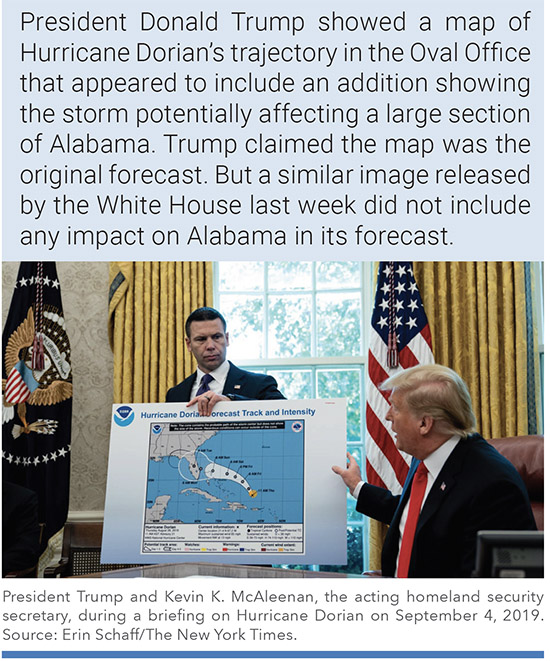 As the US President continued to press his case that the hurricane has Alabama in its path, stories relating to climate change and extreme weather continued. For example, journalist Seth Borenstein from the Associated Press reported, “Former top officials of the National Oceanic and Atmospheric Administration are assailing the agency for undermining its weather forecasters as it defends President Donald Trump’s statement from days ago that Hurricane Dorian threatened Alabama. They say NOAA’s action risks the credibility of the nation’s weather and science agency and may even risk lives. Dismay came from those who served under Republican and Democratic presidents alike as leaders in meteorology and disaster response sized up a sustained effort by Trump and his aides to justify his warning that Alabama, among other states, was “most likely” to be hit hard by Dorian, contrary to forecasts showing Alabama was clear. That effort led NOAA to repudiate a tweet from the National Weather Service the previous weekend assuring Alabamans — accurately — that they had nothing to fear from the hurricane. The weather service is part of NOAA and the tweet came from its Birmingham, Alabama, office”.
As the US President continued to press his case that the hurricane has Alabama in its path, stories relating to climate change and extreme weather continued. For example, journalist Seth Borenstein from the Associated Press reported, “Former top officials of the National Oceanic and Atmospheric Administration are assailing the agency for undermining its weather forecasters as it defends President Donald Trump’s statement from days ago that Hurricane Dorian threatened Alabama. They say NOAA’s action risks the credibility of the nation’s weather and science agency and may even risk lives. Dismay came from those who served under Republican and Democratic presidents alike as leaders in meteorology and disaster response sized up a sustained effort by Trump and his aides to justify his warning that Alabama, among other states, was “most likely” to be hit hard by Dorian, contrary to forecasts showing Alabama was clear. That effort led NOAA to repudiate a tweet from the National Weather Service the previous weekend assuring Alabamans — accurately — that they had nothing to fear from the hurricane. The weather service is part of NOAA and the tweet came from its Birmingham, Alabama, office”.
Furthermore, journalist Vanessa Romo from US National Public Radio noted, “NOAA's top scientist said Monday that he's investigating why the agency's leadership endorsed President Trump's false tweet that Alabama was in the path of Hurricane Dorian, after Birmingham-based meteorologists from the National Weather Service publicly pushed back on it. In an email, Craig McLean, acting chief scientist of the National Oceanic and Atmospheric Administration, called the move by the agency to back the president inappropriate, suggesting it was politically motivated”.
In September, cultural dimensions of climate change and global warming were picked up by media stories. For example, new polling data from CBS News as well as the Washington Post/Kaiser Family Foundation connected to the ‘Covering Climate Now’ initiative revealed some shifts in public opinion on climate change. Referring to the CBS News poll Jennifer De Pinto, Fred Backus and Anthony Salvanto noted, “A majority of Americans think action needs to be taken right now to address climate change. Most consider it at least to be a serious problem — including more than a quarter who say it is a crisis. Seven in 10 think human activity contributes a lot or some to climate change, and most feel they have a personal responsibility to do something about it, although many say they cannot afford to... Few Americans — just 1 in 10 — say humans do not contribute at all to climate change. Among this small group, most think the idea that human activity causes climate change is a lie or hoax meant to make people think the issue is more serious than it really is”.
Also, in this cultural arena, on September 13th, 16-year old Swedish teen activist Greta Thunberg’s participation (along with approximately 1,500 other youth climate demonstrators) in a protest outside the US White House earned media attention. In late August, Greta had completed a two-week journey across the Atlantic to participate in a range of climate events and actions in the Americas in the coming months (see the August summary for more about media coverage of her trip).
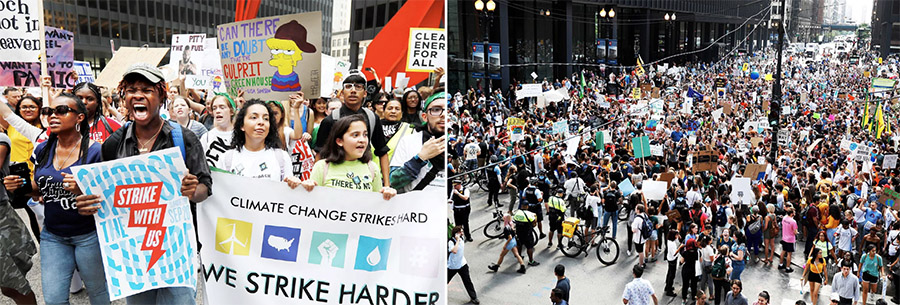
Photos: Protesters rally on the Federal Plaza in downtown Chicago, Illinois. Source: Charles Rex Arbogast/AP.
Among the many outlets covering the cultural demonstration, USA Today journalist Max Cohen from reported, “After calling out politicians for climate inaction on "The Daily Show" this week, teenage climate activist Greta Thunberg is protesting Friday outside the White House to demand the U.S. government address the effects of climate change. The 16-year-old Swede is joined by youth activists in the protest, which marks the start of Thunberg's six-day stay in Washington, D.C. Along with dozens of other youth protesters, Thunberg chanted, "Hey hey, ho ho, climate change has got to go" as the activists marched outside the White House. The students held a variety of homemade signs, including "Make Earth cool again," "Save the ice caps" and "If you did your job, we would be in school." Just before 1 p.m., Thunberg briefly spoke to a crowd that had swelled to more than 100. “I’m so incredibly grateful for every single one of you,” she said “Never give up. We will continue,” she said amid loud cheers. “See you next week on Sept. 20!”
In fact, then on Friday, September 20th, millions of people from over 130 countries were reported to have taken part in demonstrations calling for more coordinated and concerted climate action. News outlets closely covered the many gatherings. For example, Wall Street Journal journalists Tyler Blint-Welsh in New York City, David Winning in Sydney and Georgi Kantchev in Moscow reported, “The protests are designed in part to pressure governments into doing more to combat the worst effects of climate change ... Hundreds of thousands of students from across the globe took the lead during a day of climate protests before next week’s United Nations summit on climate change”.
Then the following Friday, September 27th, saw more Youth Climate Strike actions in other parts of the world. There were many media accounts of these protest actions as well. For example, New Zealand Herald journalist Julia Czerwonatis reported on this second round of global actions while Independent journalist Conrad Duncan noted, “tens of thousands of young people have marched to New Zealand’s parliament as the second wave of global protests demanding swift action on climate change began on Friday. The latest round of protests is set to see demonstrations across Asia and Europe before culminating in a rally in Montreal, Canada, where teenage activist Greta Thunberg is scheduled to speak. The march in New Zealand’s capital of Wellington earlier on Friday was one of the largest protests ever held there, forcing organisers to change their security plans to accommodate the swelling crowd”.
It was also the case that many news stories in September focused on scientific themes. Among them, a report that heavy investment in climate adaptation in the next decade could then garner significantly larger benefits/avoided costs from a changing climate generated media attention. For example, journalist Victoria Gill from BBC News wrote, “Investing $1.8 trillion over the next decade - in measures to adapt to climate change - could produce net benefits worth more than $7 trillion. This is according to a global cost-benefit analysis setting out five adaptation strategies. The analysis was carried out by the Global Commission on Adaptation - a group of 34 leaders in politics, business and science”.
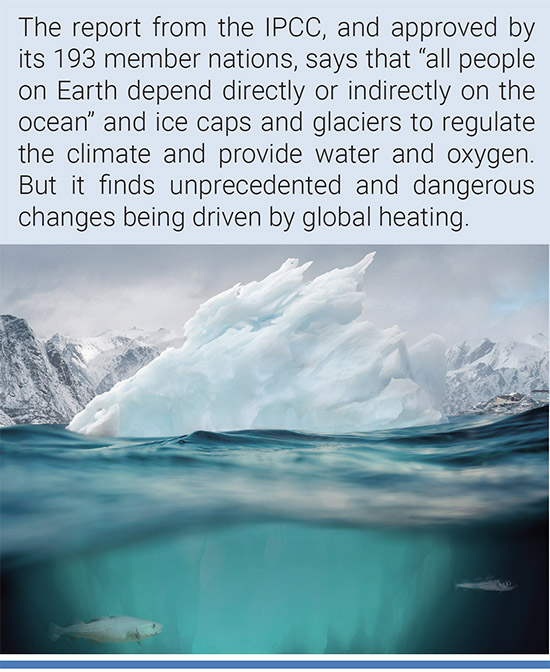 Meanwhile, journalist Frank Jordans from the Associated Press noted, “A group of leaders from business, politics and science have called for a massive investment in adapting to climate change over the next decade, arguing it would reap significant returns as countries avoid catastrophic losses and boost their economies. The Global Commission on Adaptation, comprising dozens of prominent figures including Microsoft co-founder Bill Gates and former U.N. Secretary-General Ban Ki-moon, urged governments and businesses to tackle the inevitable consequences of climate change, in addition to trying to curb it. In their 81-page report released Tuesday, the experts proposed investing $1.8 trillion between 2020 and 2030 in areas such as early warning systems, infrastructure that can withstand rising sea levels and extreme weather, and boosting agriculture to cope with droughts. Other areas they propose investing in are bolstering scarce water resources and improving mangrove forests that provide key protection to vulnerable shorelines in developing nations. Ban cited Bangladesh’s response to two devastating cyclones as a good example of the way countries can adapt to environmental threats. Following the deaths of hundreds of thousands of people in 1970 and 1991, the South Asian nation reinforced flood defenses, built shelters and trained volunteers, sharply cutting the death toll in subsequent storms. He also pointed to recent environmental devastation in the Bahamas as further proof of the importance of preparing for climate change”.
Meanwhile, journalist Frank Jordans from the Associated Press noted, “A group of leaders from business, politics and science have called for a massive investment in adapting to climate change over the next decade, arguing it would reap significant returns as countries avoid catastrophic losses and boost their economies. The Global Commission on Adaptation, comprising dozens of prominent figures including Microsoft co-founder Bill Gates and former U.N. Secretary-General Ban Ki-moon, urged governments and businesses to tackle the inevitable consequences of climate change, in addition to trying to curb it. In their 81-page report released Tuesday, the experts proposed investing $1.8 trillion between 2020 and 2030 in areas such as early warning systems, infrastructure that can withstand rising sea levels and extreme weather, and boosting agriculture to cope with droughts. Other areas they propose investing in are bolstering scarce water resources and improving mangrove forests that provide key protection to vulnerable shorelines in developing nations. Ban cited Bangladesh’s response to two devastating cyclones as a good example of the way countries can adapt to environmental threats. Following the deaths of hundreds of thousands of people in 1970 and 1991, the South Asian nation reinforced flood defenses, built shelters and trained volunteers, sharply cutting the death toll in subsequent storms. He also pointed to recent environmental devastation in the Bahamas as further proof of the importance of preparing for climate change”.
Then in late September, the IPCC released its Special Report on Oceans and the Crysophere, generated more science-infused media attention. This report provided updated assessments of intensifying hurricanes, sea level rise projections, threatened marine ecosystems and thawing permafrost, among many subjects. This special report spurred many media reports. For example, CNN journalist Drew Kann reported, “Cities from New York to Shanghai could see regular flooding, as sea levels rise faster than previously thought. Glaciers and ice sheets from the Himalayas to Antarctica are rapidly melting. And the fisheries that feed millions of people are shrinking. These are just some of the impacts that emissions of greenhouse gases have already triggered across the planet's oceans and frozen regions, according to a new landmark report from the United Nations' Intergovernmental Panel on Climate Change (IPCC). More than 100 scientists from 36 countries worked on the report -- titled the Special Report on the Ocean and Cryosphere in a Changing Climate. It is the last of three special reports from the IPCC following last October's urgent report that showed the world may only have until 2030 to keep global warming below 1.5 degrees, and August's report on climate impacts to the planet's lands”. As a second example, journalist Damian Carrington from The Guardian noted, “Extreme sea level events that used to occur once a century will strike every year on many coasts by 2050, no matter whether climate heating emissions are curbed or not, according to a landmark report by the world’s scientists. The stark assessment of the climate crisis in the world’s oceans and ice caps concludes that many serious impacts are already inevitable, from more intense storms to melting permafrost and dwindling marine life. But far worse impacts will hit without urgent action to cut fossil fuel emissions, including eventual sea level rise of more than 4 metres in the worst case, an outcome that would redraw the map of the world and harm billions of people. The report from the Intergovernmental Panel on Climate Change (IPCC), and approved by its 193 member nations, says that “all people on Earth depend directly or indirectly on the ocean” and ice caps and glaciers to regulate the climate and provide water and oxygen. But it finds unprecedented and dangerous changes being driven by global heating. Sea level rise is accelerating as losses from Greenland and Antarctica increase, and the ocean is getting hotter, more acidic and less oxygenated. All these trends will continue to the end of the century, the IPCC report said. Half the world’s megacities, and almost 2 billion people, live on coasts. Even if heating is restricted to just 2C, scientists expect the impact of sea level rise to cause several trillion dollars of damage a year, and result in many millions of migrants”.
We in MeCCO are a University of Colorado Boulder (CU Boulder) based collaboration. We now involve eight researchers based at CU Boulder but another ten researchers across seven Universities as well. Together, we will continue to analyze the political, economic, scientific, cultural, ecological and meteorological stories as they unfold. Stayed tuned for more.



